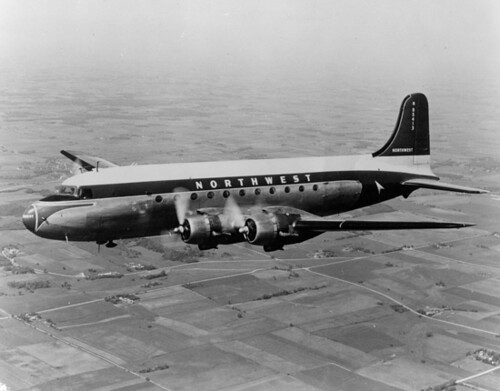The approximate 6,000 ships that have succumbed to raging storms attest to the power of the Great Lakes. As I traveled, writing and compiling information for my three-volume travel series that explores Michigan's coasts, I heard or read the tales left behind by those ill-fated ships. They add a somber, but compelling backdrop to Michigan’s waterways. The following story deviates from the shipwreck theme. In addition to the thousands of ships that surrendered to the waters of Lake Michigan, there is also one major aircraft that vanished into her angry waters.

A DC-4 similar to the accident aircraft. Photo: San Diego Air and Space Museum Archive
Fifty-five travelers (27 women, 22 men, and six children) and three crew members bound for Milwaukee and Seattle boarded a Northwest Airlines flight on June 23, 1950. It departed New York’s LaGuardia International Airport at 9:49 p.m. Passengers settled into their seats, unaware that this would be the last day of their life.
Captain Robert Lind and the two other crew members aboard the DC-4 had everything under control. Those who put their lives in Lind’s hands that night believed they had nothing more to worry about than whether they could nod off during the red-eye flight. Over Lake Michigan, in an area often referred to as the Lake Michigan Triangle (which runs from Manitowoc, Wisconsin, to Ludington, Michigan, and south to Benton Harbor), they were proven wrong.
Above Cleveland, Lind grew concerned about storms in his path, and requested a cruising altitude of 4,000 feet which was approved by air traffic control. Turbulence worsened, and he was instructed to drop to 3,500 feet to avoid a crash with another flight that was also reporting violent weather. This second flight struggled to maintain its altitude at 5,000 feet.
Lind radioed that he would reach Milwaukee by 11:37 p.m. That was the last transmission from Flight 2501 before the plane disappeared forever.
The U.S. Coast Guard Cutter Mackinaw assisted in the search for the missing plane. Captain Carl G. Bowman, skipper of the Mackinaw, radio contacted the United Press at Detroit that his men found small body parts, including hands and ears.
Additional Coast Guard ships and police departments arrived to help with the search. More body parts were discovered, but no complete bodies. Debris, which included luggage, seat cushions, and a fuel tank floating in an oil slick near South Haven, were collected. However, the main wreckage of the plane was not found. To this day, Flight 2501 remains the only missing U.S. aircraft in aviation history.
At the time the plane disappeared, it was flying through an electrical storm. Lightening bedeviled the sky. That, and the small size of the debris found floating in the oil slick, suggested an explosion. The seven-month official investigation resulted in a final report concluding “there was insufficient evidence upon which to make a determination of probable cause.”
More than 72 years later, the whereabouts of the aircraft remain a mystery. At the time of its disappearance, the crash was the worst aviation tragedy in American history. The Michigan Shipwreck Research Association (MSRA) has conducted annual searches for Flight 2501 since 2004.
Over the past decade, searchers have covered more than 600 square miles of Lake Michigan, seeking the plane wreckage. While Flight 2501 remains elusive, 14 shipwrecks dating back to the 1800s have been found during the course of the searches.
Valerie van Heest, a co-founder and researcher with MSRA, teamed up with author and explorer, Clive Cussler, to unravel the mystery. In September 2008, she found an unmarked grave near St. Joseph that she believed contained the body parts of the victims. A marker listing the 58 names of the lost was placed at the site.
But even the concerted efforts of Van Heest and Cussler didn’t reveal answers to the two main secrets: Where is the plane? And what caused it to fall from the sky? Van Heest published a book in 2013 with her findings and her account of the victims last hours: Fatal Crossing: The Mysterious Disappearance of NWA Flight 2501 and the Quest for Answers.
The Discovery Channel produced a segment about the crash of Flight 2501. Expedition Unknown aired on February 12, 2020 (season 8, episode 2).
In spite of the search efforts and the interest attendant to the crash, somewhere on the bottom of Lake Michigan, Flight 2501 molders in its grave, where it holds tight to its secrets.
Click through to read excerpts from Royce's three books exploring Michigan's coasts:
Julie Albrecht Royce, the Michigan Editor for Wandering Educators recently published a three-book travel series exploring Michigan’s coastlines. Nearly two decades ago, she published two traditional travel books, but found they were quickly outdated. This most recent project focuses on providing travelers with interesting background for the places they plan to visit. Royce has published two novels: Ardent Spirit, historical fiction inspired by the true story of Odawa-French Fur Trader, Magdelaine La Framboise, and PILZ, a legal thriller which drew on her experiences as a First Assistant Attorney General for the State of Michigan. She has written magazine and newspaper articles, and had several short stories included in anthologies. All books available on Amazon.

Help promote Michigan. Books available on Amazon.

